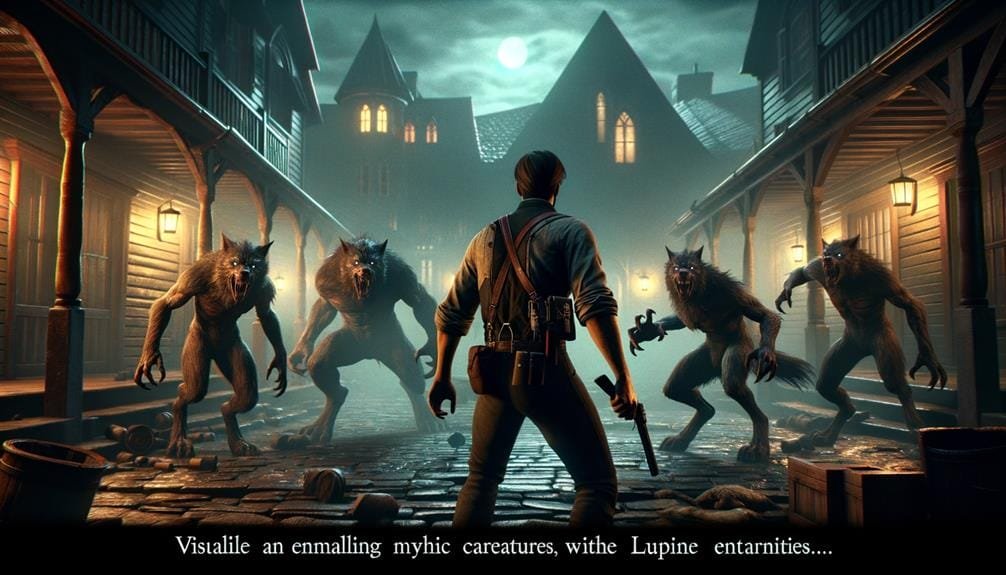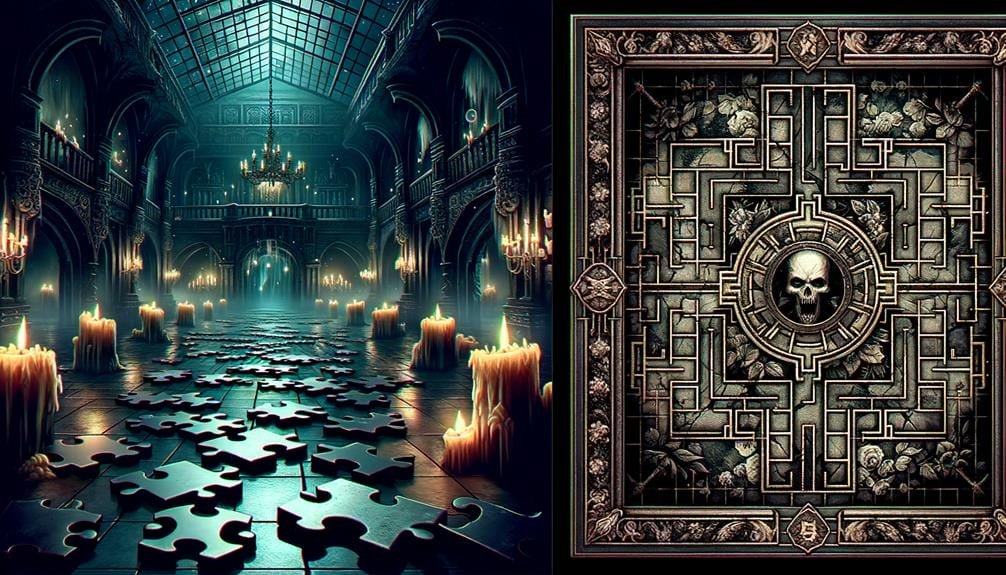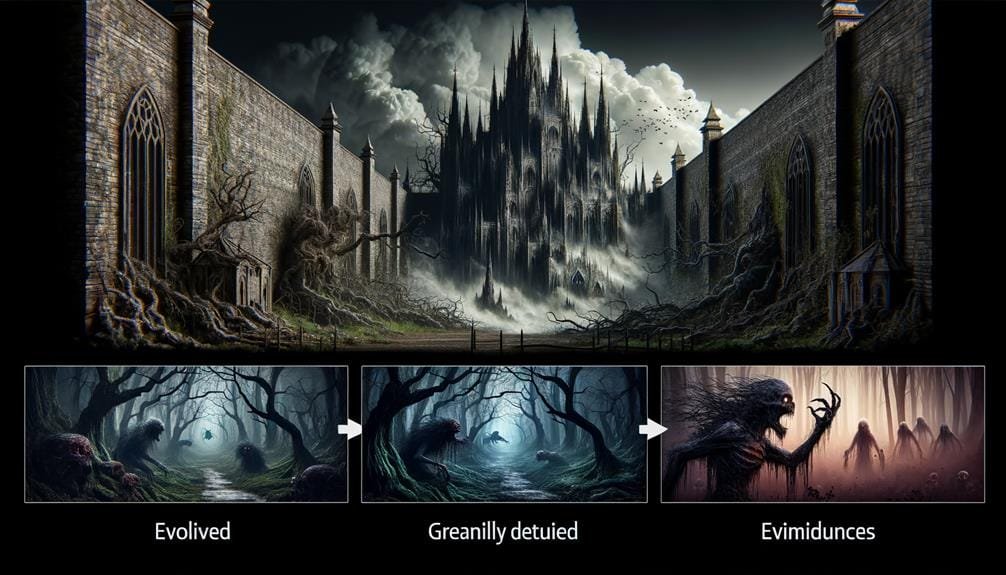Our Newsletter
Sign up for our e-mail newsletter and stay informed for what’s next on the horizon.
We’ve all journeyed through the eerie landscapes of ‘Resident Evil Village’, a game that has genuinely advanced the horror genre. Its fusion of gothic atmosphere, psychological suspense, and creative combat techniques has led us on a spine-tingling adventure unlike any other.
But can we honestly claim that we’ve solved the mystery that is Resident Evil Village? This game has numerous layers to dissect and a wide range of terrifying narratives to interpret.
So let’s start a conversation that will illuminate these hidden depths and perhaps, reveal the real brilliance behind this work of art.
In ‘Resident Evil Village – Horror Evolved’, we find ourselves plunged into a hair-raising journey, our senses overloaded by the intimidating atmosphere and monstrous foes. We’re drawn to the intricate puzzles, gripped by the erratic plot twists, and captivated by the game’s impressive visuals.
It signifies an important evolution for the horror genre, an endorsement of the power of immersive storytelling and creative design. In essence, it’s a game that reignites our fondness for terror.
Stepping into the Village Setting and Atmosphere of Resident Evil Village, it’s clear that the frosty European location based in Romania excellently amplifies the game’s spine-chilling ambiance. We’re thrown into a spooky world, where each falling snowflake intensifies the icy sense of terror that permeates the game. The village, besieged by terrifying Lycans, is a backdrop of gothic horror, a place where danger is hidden in every nook and cranny.
This village, reminiscent of the iconic setting of Resident Evil 4, provides a refreshing mix of classic horror themes and unrestricted exploration. The snowy scenes, far from being purely decorative, are skillfully integrated into the gameplay, escalating the tension as we traverse the icy environment.
We can’t overlook the ingenious use of the Roman numeral VIII in the title, highlighting the village’s importance in the narrative and gameplay. It’s a continuous pointer to the Evil that has infiltrated every corner of this village, connecting the blood-curdling atmosphere to the very core of the game. The village in Resident Evil Village, is more than a setting—it’s a character, a living, palpable embodiment of fear and suspense.
Throughout the years, the Resident Evil series has moved from its initial survival horror genre to a stronger focus on action, and currently, it has returned to its original horror base.
This evolution is clearly seen in the gameplay, as each new chapter introduces fresh tactics and survival strategies.
Additionally, there’s been a significant advancement in the visual aspect of the series. The most recent game, Village, has set a new standard for immersive and atmospheric experiences in the realm of horror games.
With the progression of the Resident Evil series, it’s apparent that Resident Evil Village is distinctive, adeptly merging classic horror with new, unnerving experiences that indicate a notable shift in the series.
The game’s creative adoption of the first-person viewpoint intensifies the immersion, amplifying the terrifying aspects. A clear divergence from the series’ usual aspects is noticeable, particularly in the narrative, where the quest of Ethan to save his daughter provides a more polished, complex horror experience.
The amalgamation of strange and extravagant storytelling with new features has struck a chord with players, leading to Village’s acclaim and market success. Reviews reinforce this view, lauding Village for its varied horror encounters and daring progression within the Resident Evil cosmos.
As we continue our journey through the Resident Evil series, we notice how Resident Evil Village has advanced its gameplay, achieving an equilibrium between traditional horror elements and novel mechanics for a varied horror experience. The quintessential Resident Evil switches between psychological horror and action gameplay, satisfying a spectrum of player tastes.
| Classic Resident Evil | Resident Evil Village |
|---|---|
| Fixed camera angles | First-person perspective |
| Pre-rendered backgrounds | Real-time 3D environments |
| Limited resources | Amplified resource management |
| Single setting | Central village design |
The central village design boosts exploration, offering a new spin to the series. From making one’s way through gothic castles to resolving puzzles in doll-infested houses, the game presents a range of varied horror experiences, indicating a substantial evolution in its gameplay.
The progression in visual aesthetics is just as notable as the evolution in gameplay when observing the Resident Evil series, particularly the most recent chapter, Resident Evil Village.
These modifications in visual elements have truly advanced the horror experience in Resident Evil.
Our focus now shifts to the ominous characters that define the terror narrative of Resident Evil Village. Ranging from the cryptic rule of Mother Miranda to the enigmas that shroud Heisenberg’s history, these personalities add complexity to the story of the game.
Every one of them poses distinctive obstacles and bolsters the escalating theme of horror.
Venturing into the gloom of Resident Evil Village, we come across the enigmatic Mother Miranda, the venerated leader who wields the game’s storyline to accomplish her dark goals. As a skillful operator with ominous aims, she’s the puppet master in the murky world, tugging at the ropes to conduct incidents and bend others to her command.
This intriguing character is marked by:
Under her rule, Mother Miranda represents the progress of terror in Resident Evil Village.
Moving away from Mother Miranda’s rule, we now shift our focus to Karl Heisenberg, a baffling figure whose history is as captivating as his current life. Heisenberg, an engineer with exceptional talent, presides over Heisenberg’s Factory, a den that offers a distinct horror experience in Resident Evil Village. His character design, diverging from typical horror cliches, augments the game’s storyline.
| Character | Role | Strength |
|---|---|---|
| Heisenberg | Engineer | Distinct viewpoint |
| Mother Miranda | Ruling figure | Dominance and authority |
| Mutant Lords | Antagonists | Intimidating presence |
Unraveling Heisenberg’s perplexing history, we encounter a multifaceted figure, one of the four mutant lords that bring complexity to the game’s antagonists. His story, unveiled as we advance in the game, is a quest for independence, a plot line that strikes a chord with the players.

In Resident Evil Village, the game mechanics and combat systems offer an engaging and tactical challenge, necessitating meticulous inventory oversight and effective resource allocation. The lack of an item box implies we must give precedence and plan ahead, with restricted slots to hold our necessary items. We can’t let possessions overwhelm our inventory; we must choose wisely.
The combat systems in each of the four significant houses provide unique experiences. Each adversary encounter compels us to adjust and reconsider our tactics, assuring an exhilarating and uncertain game progression.
Wandering through the village reveals optional adversaries that contribute an additional dimension to the game, increasing its complexity and replay potential. These adversaries aren’t just for display; they yield valuable resources when vanquished. Comprehending and mastering these game mechanics and combat systems is crucial to endure the terrors of Resident Evil Village.
While understanding the game mechanics and combat systems is vital for survival, it’s the fascinating plot twists that truly immerse us into the grim world of Resident Evil Village. Each narrative pivot reveals startling truths about main character Ethan Winters, his offspring, and the village’s sinister secrets. The unpredicted character driving forces and intricate plot turns add a richness to the game, keeping us captivated and continuously guessing.
The game effectively undermines conventional horror storytelling rules, with convoluted character identities and fluctuating allegiances. The detailed plot turns persistently challenge our comprehension of the narrative and characters, intensifying the sense of enigma and allure. As the story unravels, we’re propelled by a yearning to untangle the truth, bolstering our engagement in the storyline.
Character driving forces regularly astonish us, infusing unexpected dimensions to the narrative and further augmenting the game’s richness. This offers us a superior sense of liberty in navigating through the narrative and the world of Resident Evil Village.

Delving further into the gameplay, we find a variety of puzzle elements and challenges that substantially augment the horror experience in Resident Evil Village. Traditional lock-and-key puzzles and more intricate environmental challenges aren’t merely barriers; they’re essential components of the narrative, adding richness and interaction to the overall horror gameplay.
The game’s puzzle design keeps players vigilant, necessitating them to think tactically and pay attention to details. Here are the methods by which puzzles and challenges present themselves:
These puzzle elements have a pivotal role in the game, adding strata of complexity and challenge that keep players captivated. The liberty to solve these puzzles at one’s own speed contributes to an engaging, immersive gaming experience.
Transitioning from the mind-bending challenges, it’s crucial to not disregard the significant role that sound design assumes in intensifying the horror atmosphere in Resident Evil Village. Spatial audio and exceptional sound effects aren’t merely an ornamental feature, they’re an integral component of the game’s design. They intensify the suspense, turning every corner navigated and door unlocked into a potential fright.
The game’s deployment of cutting-edge spatial audio technology enables players to pinpoint threats solely based on sound. This degree of engagement isn’t merely remarkable, it’s horrifying. It bolsters the horror ambiance by making the menace feel palpable and ever-present.
Furthermore, auditory signals warn players of looming dangers, further escalating the suspense. If you detect a remote growl or the squeak of a floorboard, you understand something is prowling. This transforms Resident Evil Village into not merely a visual journey, but also an auditory one.

In the domain of graphics and visual aesthetics, Resident Evil Village outperforms with its intricate character models and environments, exploiting ray tracing and advanced technology to create engaging horror experiences. Our main character, Ethan Winters, and the towering adversary, Lady Dimitrescu, are depicted with scrupulous precision, augmenting the player’s engagement in the game world.
The visual aesthetics in Resident Evil Village extend beyond character models. They include:
The ray tracing technology particularly excels in these areas, offering a sense of authenticity and depth. The visual quality of the game doesn’t simply serve an aesthetic function, but substantially adds to the immersive horror experience.
The graphics and visual design of Resident Evil Village greatly improve the player’s experience, demonstrating a prime example of what advanced technology can accomplish in the horror genre.
While it’s not possible to confirm that it’s the most frightening game, this aspect can vary based on individual fears. Resident Evil Village does, however, effectively combine classic and modern horror elements, providing an eerie, varied experience that many find quite petrifying.
In our experience, Lady Dimitrescu emerges as the most terrifying creature in Resident Evil Village. Her towering presence, sophisticated threat, and unyielding chase heighten the fear, rendering our interactions with her truly memorable and frightening.
The changes to RE8’s intensity level were implemented to make the game more accessible to a broader audience. By integrating elements of thrill and action, we have curated a wide array of engaging experiences, providing diverse narrative and gameplay possibilities. The element of dread remains, though it has been transformed.
After extensive discussions and gameplay analysis, we’ve concluded that Resident Evil Code: Veronica is the most difficult game in the Resident Evil series. Its complex puzzles and formidable adversaries push your gaming skills to their limits.
In ‘Resident Evil Village – Horror Evolved’, we’re immersed into a spine-chilling expedition, our senses overwhelmed by the daunting ambience and beastly adversaries. We’re fascinated by the complex riddles, held tight by the unpredictable narrative turns, and mesmerized by the game’s striking imagery.
It’s a significant progression for the horror genre, a validation of the strength of engaging storytelling and inventive design. Essentially, it’s a game that rekindles our affinity for fear.
Sign up for our e-mail newsletter and stay informed for what’s next on the horizon.